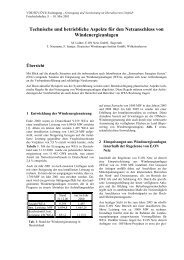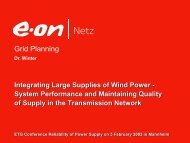controller parameters by using a decoupling filter
controller parameters by using a decoupling filter
controller parameters by using a decoupling filter
Create successful ePaper yourself
Turn your PDF publications into a flip-book with our unique Google optimized e-Paper software.
B. Operation during AC faults<br />
The AC fault applied to the HVDC system is a 50%<br />
voltage jump at the AC side of the inverter; it is presented<br />
in Figure 11.<br />
Time/sec.<br />
Figure 11: 50 % voltage jump from t = 0.5 sec to t = 0.7 sec<br />
applied to the inverter AC side of the HVDC system with a) the<br />
classical <strong>controller</strong> b) the <strong>decoupling</strong> <strong>filter</strong> <strong>controller</strong><br />
During the AC fault, the rectifier firing angle decreases<br />
and is controlled to its average reference value. The DC<br />
current drops to zero. Applying the classical control the<br />
current overshoot after the fault is much higher than<br />
applying the <strong>decoupling</strong> <strong>filter</strong> <strong>controller</strong>. The <strong>decoupling</strong><br />
<strong>filter</strong> reacts much faster than the classical <strong>controller</strong> and<br />
reaches its reference level much earlier regarding the DC<br />
voltage.<br />
5. Conclusion<br />
a)<br />
Time/sec.<br />
b)<br />
In this paper a novel approach for the selection of HVDC<br />
<strong>controller</strong> <strong>parameters</strong> was presented. First the<br />
mathematical modelling of an HVDC was shown, thus it<br />
was revealed that the HVDC is a coupled system due to<br />
the firing of the rectifier influences the DC current and the<br />
DC voltage at the inverter; the same applies for the firing<br />
of the inverter respectively and was presented in Figure 3.<br />
Accordingly a <strong>decoupling</strong> <strong>filter</strong> was designed for the<br />
HVDC system and it was shown, that the system can be<br />
considered as mathematically uncoupled.<br />
This method offers the possibility to select the HVDC<br />
<strong>controller</strong>s and their <strong>parameters</strong> in a sophisticated way<br />
that takes the HVDC <strong>parameters</strong> of the mathematical<br />
model into account. Therefore an appropriate <strong>controller</strong><br />
for each HVDC system can be designed; unlike the<br />
<strong>parameters</strong> of classical <strong>controller</strong>s which were obtained<br />
<strong>by</strong> trial and error.<br />
The <strong>controller</strong> was tested in a realistic environment and it<br />
was shown, that the developed <strong>controller</strong> operates well<br />
and that it behaves even better under certain operating<br />
conditions than the classical HVDC <strong>controller</strong>.<br />
It was also shown that the curves of the firing angles are<br />
very smooth, therefore no additional software smoothing<br />
<strong>filter</strong>s would be necessary in the <strong>controller</strong> like it is<br />
necessary for the classical <strong>controller</strong>.<br />
References<br />
[1] O. Feix, R. Obermann, M. Strecker and A. Brötel,<br />
“German grid development plan, (Netzentwicklungsplan<br />
Strom)“, German Transmission System Operators, Berlin,<br />
Germany, August 2012 (in German).<br />
[2] L. Ni and Y. Tao, “Parameter Optimization of the Control<br />
and Regulating System of Gezhouba-shanghai HVDC<br />
Project”, Power System Technology, No.3, pp.26-31, Aug.<br />
1989.<br />
[3] V. Crastan and D. Westermann, “Electrical power supply<br />
III, (Elektrische Energieversorgung III)”, Springer<br />
publishing, Berlin Heidelberg, Germany, 2012 (in<br />
German).<br />
[4] F. Yang and Z. Xu, “An approach to Select PI Parameters<br />
of HVDC Controllers”, Power Engineering Society<br />
General Meeting, Montreal, Québec, Canada, June 2006.<br />
[5] A. E. Hammad, “Stability and Control of HVDC and AC<br />
Transmissions in Parallel”, IEEE Transactions on Power<br />
Delivery, Vol. 14, No. 4, October 1999.<br />
[6] F. Karlecik-Maier, “A New Closed Loop Control Method<br />
for HVDC Transmission”, IEEE Transactions on Power<br />
Delivery, Vol. 11, No. 4, October 1996.<br />
[7] O. Föllinger, “Control Engineering, (Regelungstechnik)”,<br />
Hüthig publishing, Heidelberg, Germany, 1994 (in<br />
German).<br />
[8] T. Rae, E. Boje, G. D. Jennings and R. G. Harley,<br />
“Controller structure and design of firing angle <strong>controller</strong>s<br />
for (unit connected) HVDC systems”, 4 th IEEE Africon<br />
Conference, Stellenbosch, South Africa, September 1996.<br />
[9] C. Hahn, M. Weiland, G. Herold, “Control design for a<br />
power electronic based fault current limiter (FCL)”,<br />
International Conf. on Renewable Energies and Power<br />
Quality (ICREPQ), Santiago de Compostela (Spain), 2012.





